 very day I'm surrounded by the rattling of gunfire, the constant drone
of heavy equipment, and the roar of jet aircraft, C-130s, and helicopters
overhead. Welcome to the burbs, which now resemble Operation
Desert Storm without all the sand.
very day I'm surrounded by the rattling of gunfire, the constant drone
of heavy equipment, and the roar of jet aircraft, C-130s, and helicopters
overhead. Welcome to the burbs, which now resemble Operation
Desert Storm without all the sand.
When I was a student, for a time I lived next to a bar. There were people outside my window at 3 AM by trying to kill each other all the time, but there it was mostly just handguns, knives, and baseball bats. Not so in the burbs, with our AR-15s, our 5500 pound SUVs, and our string trimmers capable of firing a hundred tiny rocks per second.
I have an interstate a mile away in one direction, a big airport over the hill, and trains blasting their horn every half hour starting at 3:30 am. My neighbors have lawnmowers the size of bulldozers and leaf blowers so powerful that if you point them east the Earth slows down. They also have a variety of different firearms. The quietest is the handgun, which we heard all the time in Maryland; the three rapid-fire blasts from an AR15-style battle carbine; and shotguns, which are the loudest, registering 70 dBA from a quarter mile away.
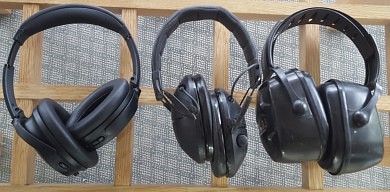
Earmuffs used in the test. Left to right: Bose QC, Peltor Tactical 100, Thunder T3. Note small dummy 2.5 mm phone plug protruding from lower left of the Bose
I haven't bought any of those yet, but when my old push mower died the sound pressure level (SPL) of a new one was 92 dBA at three feet away. That's 10 dB higher than my old one, equivalent to ten-fold higher sound intensity.
All great fun. But when one neighbor got not one but two roosters, I could stand all this suburban peace and tranquility no longer. People think roosters only crow at dawn. No. They crow continuously from 4 AM till dark—every eleven seconds. Last night they started at 3 AM and were so annoying that even the wild foxes started howling. It's a cock concert over there. Clearly I needed something to drown them. . . . Out. Drown them out.
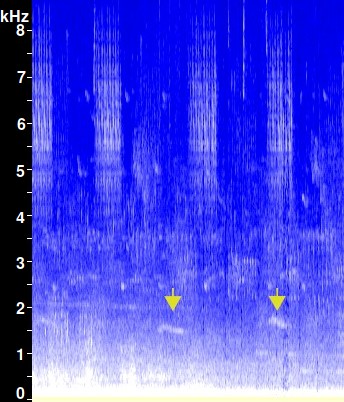
Recording of a rooster crowing with FedEx jet plane taking off in the background. The characteristic descending pitch of the rooster is visible on the sonogram at 1.5 kHz (arrows). The plane is louder than the chickens and the second rooster has been drowned out
Now, you might say in the grand scheme of things this is not such a big deal. But life sucks, and life sucks even more when you've been driven mad by something trivial. And as we'll see, there's a legitimate reason why this is important.
Bose Quiet Comfort
Active noise-canceling technology has vastly improved in the past decade. The original Boses sat on your ears and were painful, while the early Sonys would emit a loud feedback squeal if you accidentally put your hand over the microphone. If that squeal blasted into your ear it would probably cause instant hearing impairment. These flaws don't exist anymore (the mike is now oriented differently to prevent squealing, though it still squeals if you remove the cloth and touch it). They're comfortable enough to wear for hours and they were on sale now that the Ultra came out last year.
The biggest weakness is they only actively reduce sound at frequencies up to about 1000 Hz. They rely entirely on passive blocking for higher pitched sounds, so their main benefit is to reduce stress from continuous roaring sounds, like lions sneaking up on you or trains coming up behind you while you're walking on the tracks.
Like the earlier QC45, music sounds brighter through the headphones than from its original source, possibly because the sound cancellation blocks the lower frequencies. People sound ten years younger and a lawnmower sounds weird, almost like a toy, with all the low freqs attenuated. It wouldn't make sense to use these just for listening to music; their job is to protect your ears and your sanity.
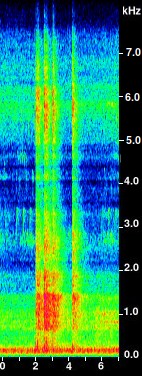
Sonogram of a neighbor's firearm (only four discharges shown; neighbor may have run out of ammunition) shows broadband sound
Earmuffs
Below are some measurements taken with a professional grade sound level meter comparing representative examples of the three main types of earmuffs: the Peltor Tactical 100, which cancels loud transients; the Thunder T3, which passively muffles all sounds by up to 29 dB; and the Bose QC.
The Peltors are intended for a shooting range and are ideal for lawn mowing. They're rugged and they have a built-in sound amplifier that allows you to hear conversations normally. When a loud noise is detected, the amplifier gain instantly cuts off so that only loud noise from a firearm, lawnmower, or barking dog is dampened. The Thunder T3 is big and makes you look like a runway ground controller at an airport. Similar ones have built-in AM/FM radios, which sounds counterproductive, and some have Bluetooth. Watch out for other websites that call them “noise-canceling” when in fact they're merely passive. Their 29 dB reduction is achieved partly because they press strongly against your head.
The sound sources were a white noise generator, a band saw (medium pitched noise), and a drill press (low pitched). The Thunder T3 is clearly the best passive earmuff, while the improvement from active sound canceling is only effective at low frequencies.
Comparison with earmuffs| White noise | Band saw | Drill press | |
|---|---|---|---|
| Baseline SPL, dBA | 89.3 | 84.0 | 73.0 |
| ΔdBA quieting | |||
| No earmuffs | 0 | 0 | 0 |
| Peltor tactical 100 | 28.8 | 20.1 | 19.8 |
| Thunder T3 | 32.2 | 28.3 | 25.0 |
| Bose (off) | 21.3 | 10.4 | 16.6 |
| Bose (on) | 22.8 | 23.0 | 22.4 |
ΔdBA is reduction from baseline for various sound sources measured 6 inches from the source.
(Update) Here is a frequency response curve of the sound cancellation of the Bose. The red curve shows that the active canceling is mainly between 100 and 800 Hz. Above 935 Hz the dampening is entirely through passive muffling and active canceling slightly works against it.
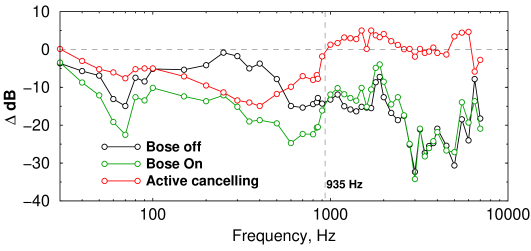
Frequency response curve of Bose Quiet Comfort. Black line is the sound reduction with the Bose in front of the sound level meter, but powered off. Green line is with power on. Red line is the difference, which is the amount of active cancellation. Above 1 kHz the 'cancellation' actually makes the noise slightly louder
Below is a comparison of background noise on a Sunday at 6AM outdoors before sunrise. The main noise was a train 1.5 miles away. The Bose reduced it by six dB passively and an extra six decibels actively, but had almost no effect on background noise at low sound intensities. (Normal background around here is 50–55 dBA, which they all block effectively; a train horn 1.5 miles away raises it to 70, which makes conversation impossible).
Dogs bark at frequencies around 500–800 Hz, near the upper limit of active cancellation.
Comparison with earmuffs| Train running 1.5 miles away |
No train | |
|---|---|---|
| No earmuffs | 47.4 | 42.0 |
| Bose (off) | 41.9 | 36.0 |
| Bose (on) | 35.7 | 35.4 |
Ultrasound and infrasound
You might think, as I did, that removing only low frequency sound is just a convenience that helps to remove stress. But there's new evidence that sounds outside the range of human hearing can contribute to hearing loss and tinnitus. That's why this stuff is important.
In the past, there was much debate on the effect of ultrasound (above 20 kHz, which humans cannot hear but which contains a lot of acoustic energy). The general belief now is that hearing loss from ultrasound is caused by subharmonics produced by interaction of the ultrasound with objects which makes them vibrate at audible frequencies.
Infrasound at frequencies below 20 Hz was also thought to be harmless. However, a paper in March 2024 Trends in Hearing [1] says that intense vibration and high intensity low-pitched sounds such as those in a tank or armored vehicle can induce hearing loss at low and mid frequencies. They cite research that says infrasound (below 20 Hz) and low frequency wind noise (250–500 Hz), such as that experienced by motorcycle riders, can induce hearing loss, hyperacusis, and tinnitus despite barely registering on the conventional A scale, which is weighted for human hearing. They also say that passive attenuation from earmuffs or earplugs is ineffective at low frequencies and active sound cancellation is recommended, especially for artillery personnel in armored vehicles.
This means risk factors from sound may need to be based on the C scale as well as A. It's of note that it's common to register sound >100 dB on the C scale in an ordinary car.
Bose QC - disadvantages
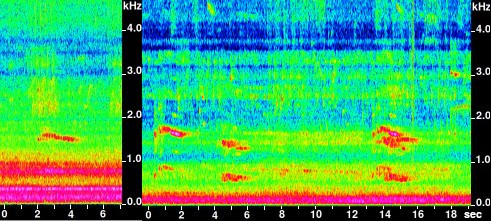
Left: Sonogram of one of the roosters. Red area below 1 kHz is mostly traffic and airplane noise, which the active cancellation gets rid of. Right: Sonograms of two roosters early on Sunday with less background noise. The smaller rooster crows at 1.6–1.7 kHz. The bigger one crows at 0.7 kHz with a strong harmonic at 1.4 kHz. At 14 seconds they're having a party
The Bose tries to connect to your cell phone over Bluetooth. If your phone isn't close enough, a nice female voice nags you every few seconds. The only way to keep her quiet and disable Bluetooth is to attach the 2.5 mm 4-conductor cable or insert a dummy 2.5 mm phone plug into the headphones. A piece of metal like a 0.098 inch drill bit also works, but it would be inconvenient to walk around with a drill bit sticking out of your head. I'm sure my HOA has a rule against that.
The Bose QCs are nowhere near rugged enough for military or industrial use. A Bose used in a tank would probably not last ten minutes. When they're turned on, sounds from your phone, including keyboard clicks, are sent to the headphones, making the phone unusable. This could be a problem if you leave the headphones turned on by mistake after wearing them.
Manufacturers need to make active sound cancellation work at infrasonic frequencies and at frequencies up to 2 kHz, which is the frequency used by roosters as well as human babies on airplanes, often called nature's most potent acoustic weapon. Or they could use AI to learn and generate a waveform to cancel the interfering sounds. It's easy to think of ways technology like that could be beneficial. In this case, I used a white noise sound generator through a cheap 10-band audio equalizer. Though not as quiet, it masked the bird sounds by making a narrow-band hissing noise.
Before your chickens come home to roost, please think of your poor neighbors who have to listen to them.
Update: We just had a big windstorm. Chickens are pretty aerodynamic, so I was hopeful that it would solve the noise problem. But they came back. Evidently they're not aerodynamic enough. Then it rained so hard the NOAA weather radio was knocked out. The airport was also knocked out and has been non-towered for a week. The chickens lived on. They are indestructible.
[1] Moore BCJ, Cox G. Sensitivity of Methods for Diagnosing Noise-Induced Hearing Loss in Cases of Exposures Including Intense Low-Frequency Noise. Trends Hear. 2024 Jan-Dec;28:23312165241240353. doi: 10.1177/23312165241240353. PMID: 38545653; PMCID: PMC10976500. Open access at DOI link.
apr 01 2024, 6:07 am. updated apr 04 2024. sonograms added apr 09 2024 frequency response curve added jul 28 2024
